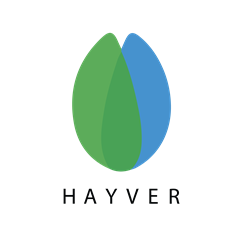Interview with the Hayver App Team

Hayver plans to use the funds raised from an ICO to promote an app that can help recovering addicts improve their chances of avoiding relapse. The app provides rewards for activities such as daily check-ins and passing randomized testing. I caught up with CEO Barry Hayut, CMO John Copenhaver, and media specialist Dawn Van Dam for this interview.
Dawn: Barry Hayut is the CEO and co-founder and John Copenhaver is the—are you medical officer or scientific officer or both, John?
John: I’m the other co-founder and Chief Medical Officer.
Dawn: Right, yeah, I was going to get to co-founder, so Chief Medical Officer. And I’m supporting the team in reaching out to people like yourself, Heidi, and trying to get the world to know about what we’re doing here with Hayver and the Duitcoin.
Now we see Barry closer. Are you on audio yet, Barry?
Barry: Yes, I am. I had to—when I closed the web app it closed my phone, so I had to redial.
Dawn: Maybe I’ll just start off, Heidi, and give you a few statistics and then I’ll let Barry and John jump in and talk to you some more about Hayver and also our cryptocurrency launch, which is going to be happening soon.
I’m not sure how much you know about the area of addiction, but when we look at addiction in general, of the 323 million in the United States, about 53% of them have a relative who’s an addict. More than half of the people—if we use the United States as an example—have a relative who you’re actually touched by the fact that they have an addiction to either alcohol or drugs or opiates, things like that.
In the recovery area, once people have decided to take some action, there’s about 2.2 million people who are addicted, who are in recovery each year. That’s a pretty phenomenal number, 2.2 million people, but that comes out of a number of 20.8 million people in the U.S. who struggle. Really, there’s almost 21 million people who struggle and only 10% of them actually go into recovery each year.
The really sad part is, even though those people are in recovery, about 97% of them, when they leave recovery and the treatment centers, in about five years, 97% of them will relapse or they’ll no longer be in recovery. It’s pretty significant.
Really what happens is their life is kind of destroyed there. They lose their jobs, they have broken families, they have DUI arrests, and in the end sometimes, because they have no money, they commit crimes and therefore go into the jail system, etc., etc.
The opportunity with Hayver, and I’ll maybe let John jump in first and tell about this, is with Hayver, Hayver can reverse those odds and at five years, 78% of people can actually still be clean and sober. Instead of having 97% of people relapse, Hayver can allow the to have 78% of the time be still free of drugs or alcohol or addiction.
Any questions about that before John jumps in?
HH: Sure. One thing I wanted to ask is, what are some of the challenges in fighting drug addiction that a blockchain app like Hayver can solve?
Dawn: John, why don’t you jump in and tell her some more about the app itself and then Barry could kind of jump in and talk about the blockchain application.
John: Okay. Well, as Dawn just mentioned, that I’m a physician and looking at the literature of what actually help people stay sober, the main thing after 40 years of research, has been shown that the daily possibility of being randomly drug tested that day is the largest psychological deterrent to help people stay in recovery.
Being a physician, I’ve been in such programs like that and the benefit of a psychological deterrent is paramount and there really hasn’t been anything shown in the scientific literature to show how to keep people in long-term recovery. This is how physicians treat themselves.
A psychological deterrent is one aspect of our app and the main aspect that’s been shown to help people stay in recovery, but there’s another aspect of our application, is rewards. We’re taking the application and platform one step further. We are going to reward in real cryptocurrency that has value and a means to create an economy of which to increase the value of that cryptocurrency. We’re taking not only a scientifically proven aspect of psychological deterrent through our app, but we’re adding rewards of a real cryptocurrency. They’re just now coming out with papers—well, just in the last five years or so, showing that real, tangible rewards also help people stay in recovery. The two-prong approach is a very unique and very novel aspect of helping stay in recovery.
Barry: In addition to that, I would like to add that another foundation of our program is the Circle of Support, or the support group, as others may refer to it. Our support group is a peer-to-peer support group, meaning that the addict will have his family, spouses, kids, friends, therapists, sponsors, whomever they want in that Circle of Support.
As a peer-to-peer—which we already have. We already have that platform. We built the cloud-based platform and it’s already working today and we already have users. We have businesses that manage the populations already on the platform.
Like John said, we’re venturing into the blockchain technology for obviously the currency, for the rewards, that he just said, but also, that’s going to open a very big opportunity for us in terms of being able to more granularly—on a granular level—be able to actively manage activities and rewards by using smart contracts and evidently—first of all, between the support group and the addict.
Another major thing that we are building is something we call the Hayver Recovery Score. The Hayver Recovery Score is an algorithm that tracks your activity on the application every day. It’s going to assign you a daily and cumulative score. The cumulative score, the best analogy to think of it, it’s like a FICA score that people try to use to predict credit when they give you, so this recovery score first will be a basis for us to try to predict a future relapse, based on what’s going on. Second, it will be a basis for the rewards that John has just described.
Also, we intend to have future services to help people build bridges back to normal life, whether it’s credit cards, employment, whether it’s from us or third party employment, insurance and other services and products that people that go into addiction end up burning those bridges. Having a ledger, a blockchain ledger where you’re going to have your score and you’re going to have your activities is going to help us build—and we are building—an API on the blockchain to enable other wellness and health application builders, other ecosystems around the world, build their own applications, instead of everybody has to build his own reward currency, his own blockchain infrastructure, we are building one and we are going to make it developable through an API that everybody who wants to reward healthful behaviors, they can use our coin. They need the infrastructure, the ledger.
Another thing we’re going to be doing is collecting insuring data, scientific data of behavioral health, that will be available as well.
The blockchain technology is allowing us on a granular level, to be able to not only manage the relationships between the monetary people and the support group, but also help us and other third-party service providers provide service in a way that is not as efficient today.
HH: Awesome. Where are you on the Hayver road map now and what are your goals for the future and how will the ICO help you meet those goals?
Barry: Right now, we already launched in February this year, our cloud-based solution. It was in beta and we have recovered residents that started using it in the beta process. They’re paying us a subscription on a per-user basis.
Then in May, after we came out of beta, we released it to the B to B market so we have more residents and treatment centers already using it. We started building our cloud-based technology, so we’re still in the design phase. The ICO money is going to help us—first of all, we need the coin to go and do the reward thing, but the ICO money is going to primarily help us to develop that platform that we want to develop not just for Hayver, but also to spur ecosystems around the world and connect together and create this ecosphere of healthy behaviors, of applications, whether it’s addiction, chronic diseases or other healthful behaviors, so that’s one user process.
The other user process is going to be for the business and the marketing. It’s taking a lot of education and a lot of effort to make people understand. People think they go into a treatment center, don’t talk to at the beginning that only 10% of the people that go through get any treatment. But when they come out of the treatment, they think, okay, you fixed me, I’m good. But it’s not. The problem is behavioral. I mean, they got in there because there was something bad with the behavior.
In order to keep the behavior intact, they have to be monitored. That’s what the science and the programs have proven. That education, that piece of education, where people go and they need to understand that they need to be monitored and they need to be part of a support group for years, maybe for life. It’s going to take a lot of money.
40% of our money actually is going to go to marketing and education. 20% of it is going to go to development. 10% we’re going to set up a foundation. About a year after Hayver develops and put everything, we’re going to take 70% of the coins that we are allocating, we’re going to put in a foundation, we’re going to put 10% of the revenue into the foundation, and let the foundation proliferate healthy behaviors and ecosystems around the world. The 30% will be useful, what I just said, to continue to proliferate behavior ecosystem.
HH: What are some of the benefits to investors who might be interested in your ICO?
Barry: Well, the benefit is huge. Once they purchase the coin, they have the possibility of seeing a very good appreciation over time in the price of the coin. As the company continues to put that money to work, build the network, and increase its user base, the value of the coin—because we’re going to create a demand to the coin—and the demand is that we’re not just going to be basically dispensing reward coins. There’s an economy where people will have to buy the ability to—we’re going to incentivize them paying with the coins.
People will be incentivized to buy the coins and pay for the services right up there with credit cards. We also are talking to our partners to offer their services and accept payment in Duitcoins. We’re calling it the Duitcoins, in our coins.
We’re creating an economy that everybody in recovery will be incentivized to offer his services and accept payment in Duitcoins. That demand and that proliferation will create an increased demand for the coin.
The second thing that they’re going to get is, we are going to donate, every time somebody buys the coin, they’re going to be donating recovery services to a foundation or somebody they know. That’s something that we sill need to put together exactly what will be the ratio.
Not only are they buying a coin that they believe will bring them a return on their purchase, but also, they will be directly donating as a bonus, as a buy one get one free type of thing, a bonus by donating free recovery services to help people overcome addiction.
HH: That’s all the questions I have. Anything else you want to add?
Dawn: I was just going to say that from the perspective, Heidi, that everything else that’s happening in the blockchain area, really, this is one of the first forays into changing healthcare. We all know that when we’re trying to convince somebody to take better care of their health, it’s often an uphill battle, but to incentivize people and to give them some rewards for that, I think is really revolutionary. The fact that people all around the world with the addition of the blockchain will be able to access healthcare that they couldn’t have accessed, is again, a phenomenal opportunity to help people with addictions from all the corners of the world.
I forget what the phrase is, but the world can be just a small community, but only if we can touch each other and help each other
This is the really true opportunity, I think, with Hayver and the Duitcoin, is that we can make healthcare globally accessible from an addiction perspective, and make people be able to stay in recovery and all that work that they put in, so we have a chance to change so many lives. Even in the U.S., 80,000 people a year die from addiction-related problems. That’s a phenomenal number of people and it’s often young people who get caught in this circle and they can’t get out. It really is a way to help everyone around the world and make a phenomenal difference.
HH: Awesome.
Dawn: Great. Well, thank you so much for your time, Heidi. I’ll send you a follow-up note just because I just want to make sure that we’ve gotten all the facts that you need and everything is really clear and we can help you in whatever way you’re going to talk about this in your blog.
HH: Awesome. I’ll be sure to send you a link when I get it up.
Dawn: Okay, great. Thank you so much.
John: Great, thank you!
Barry: Thank you very much.








